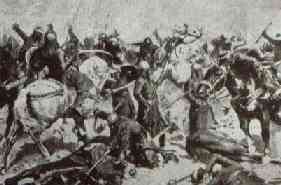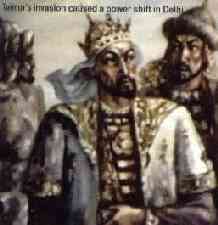
Top
|
Date: January 8, 1026
Weather:Cold
Terrain: Flanked on one side by sea and a lightly wooded forest on the other. Desert less than 50 miles northwest (direction taken by the attacking force).
Strategy: Mahmud of Ghazni marched from Multan with 30,000 cavalry and a multitude of volunteers eager for plunder. Mahmud employed a combination of swordsmen and archers on horseback in an arc with a deep defensive force in the middle. The surprise attack resulted in a shower of arrows from archers and was followed by a ladder-borne mounting of temple ramparts. The king of Somnath fled with his entourage while the temple was protected by 50,000 poorly armed faithful with little military training. Mahmud scored with surprise, cavalry charge, better logistics and motivation of jihad.
Significance: The temple's ruthless plunder was a psychological setback to Hindustan. It set an example of India as a very rich but very poorly defended place - ripe for loot.
|

Top
|
Date: 1192
Weather: Moderate
Terrain: Flat. Western extremity of the Gangetic plains.
Strategy: Prithviraj Chauhan, the king of Delhi was complacent after his success in the First Battle of Tarain in 1191 where he had defeated Mohammed Ghauri. This time Prithviraj was hamstrung as his tow chief generals were unavailable. Ghauri attached the rear lines of Prithviraj which were completely out-flanked. Though Prithviraj's cavalry launched a very effective counter-attack, forcing Ghauri's retreat, the Rajput ruler didn't press home the advantage. The flanks of Prithviraj's forces were attacked by Ghauri's light cavalry. The sideways disruption caused a sudden halt and hesitation in Prithviraj's advance, and chaos in the rear which was moving forward. Tactically it was brilliant - it resulted in denial of space to Prithviraj which neutralized his numerical superiority. Once boxed in his troops were massacred.
Significance: The battle established the sultanate in Delhi.
|

Top
|
Date: 1398
Weather: Cold
Terrain: River-crossing at Attock - the same place where Alexander had crossed the Indus 1,700 years earlier. Slightly hilly.
Strategy: The attack was in line with the Turkish-Mongol style of massed waves of attacks. Estimates vary but with 92 squadrons of cavalry the number could have been as high as 60-80,000. The Mongols who attacked Delhi were cavalrymen of a different order who could virtually live on horseback. This force, drawn by the news of weak sultans in Delhi (the Tughlaq dynasty had ended and Delhi was ruled by Nusrat Shah), simply steamrolled all opposition till its destination. Nusrat Shah fled after weak resistance. The victory was followed by the sacking of Delhi and a general massacre of the population.
Significance: Taimur's raid ended the supremacy of the sultanate in India. In the aftermath of the attack the influence of the sultanate remained only for 200 miles around Delhi. It also marked a power shift from Afghans to Turks and Mongols.
|

Top
|
Date: April 21, 1526
Weather: Hot
Terrain: Flat alluvial plain near the city of Panipat
Strategy: Babar, the invader from Samarqand, had 25,000 infantry and cavalry while Sultan Ibrahim Lodhi had a massive army of 1,00,000. For the first few days neither army moved. Then Babar sent 5,000 men for a sneak right attack. Although they were beaten, the momentum of battle swung in
favor of Babar - Lodhi's armies moved the next day. Babar employed his cannons with great effect and induced terror in Lodhi's ranks. The well-defended middle of Babar's army pressed forward in flanking 'flying column' attacks with his cavalry. The attack from the left showered Lodhi's forces with accurate musket fire while the right absorbed the brunt of Lodhi's counter-attack and pounded his
defenses with artillery fire. Babar was in teh center with a panoramic view of the battlefield. The battle ended by late afternoon with at least 20,000 of Lodhi's troops dead including Lodhi himself.
Significance: First major battle to be won by artillery and against such superior numbers. The battle led to the establishment of the Mughal Empire in India. "Not for us the
poverty of Kabul again," Babur records in his diary.
|

Top
|
Date: November 5, 1556
Weather: Cold and windy
Terrain: Flat alluvial plain
Strategy: Hemu (Hemachandra), the King of Delhi had lost most of his
artillery in an earlier battle where his advance guard had been defeated. However, his 50,000 soldiers struck rapidly at Akbar's force of 25,000 and were turning the battle into an easy victory for Hemu. Suddenly, Hemu
was struck in the eye by an arrow which also pierced his brain. As in many medieval battles the loss of the leader caused panic among the troops and the tide turned the other way. At this point a concentrated artillery attack by Akbar's general - and mentor - Bairam Khan turned the tide of the battle. Later, Akbar beheaded Hemu and exhibited his head on a spike outside the gates of his fort in Agra.
Significance: The battle gave the Mughal Empire a firm base. This was the first empire which ruled with the capability to aggregate as many as 5,00,000 troops at short notice and, therefore, had a qualitatively firmer grip on its empire than the preceding sultanate.
|

Top
|
Date: January 26, 1565
Weather: Mild
Terrain: Rocky and arid.
Strategy: The Muslim kingdoms of Ahmadnagar, Berar, Bidar, Bijapur and Golconda combined forces against Vijaynagar. It was one of the few medieval wasrs fought using a joint strategy. The attack also had material help
from some Hindu kingdoms. The battle was hard fought; the Vijaynagar empire had 10,000 horsemen and 1,40,000 foot soldiers. However, the critical
strength of attack was in its superior supply line as it was being fed from five
sources. The combined invading Muslim force of 80,000 infantry and 30,000 cavalry launched a classic offensive with a massive frontal attack. This was made possible by an initial artillery barrage that softened up the Vijaynagar army's offensive capability. the attack was brief and concentrated; the aftermath was the pillage of Vijaynagar.
Significance: Politically it sounded the end of significant Hindu kingdoms in India, and the last great southern empire. This battle
signaled the beginning of chaotic fights among the Deccan kings who ultimately played into the hands of European invaders.
|

Top
|
Date: June 23, 1756
Weather: Hot and humid, some rain
Terrain: Rocky plain.
Strategy: The battle was won even before it was fought. Robert Clive, the plucky representative of the East India Company employed persuasive diplomacy and offered Mir Jafar, a general of Bengal's Nawab Siraj-ud-daullah, the Nawabship after the war, in return for staying away from combat. Clive also bought over the chief financier of the Nawab called Jagat
Seth. Clive had 3,000 troops and Siraj-ud-daullah 50,000. But this seemingly disproportionate array of forces was
neutralized by the fact that Mir Jafar's forces of about 16,000 - which included cavalry and heavy guns - did not participate. Moreover, the
reliance on heavy guns by the Nawab backfired - some of his ammunition burst, causing panic among the elephants and oxen which were dragging the heavy guns. The end of the battle came quickly with Company forces
playing on intrigue, chaos and their own quick - footedness.
Significance: The British Raj was firmly established after this battle. With this victory the 24 Parganas in Bengal, Bihar and Orissa came under East India Company control.
|






